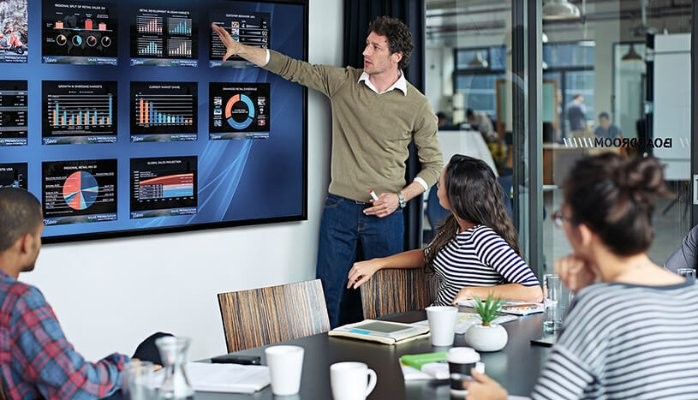
Why Video Conferencing is No Longer Enough: Raising the Bar for Collaboration
Collaboration has evolved continuously. Once it meant working together in a room. Not long after it meant video conferencing across the country or world. Today it means a whole lot more than simple video conferencing.
When video conferencing first came into the enterprise it completely changed the game as it enabled participants who were not in the same room to see and react to each other during meetings. But collaboration goes way beyond just seeing. In today’s enterprise - where you have a mix of in-office and off-site team members - collaboration needs to happen in-real time across every size screen, from mobile devices to large-scale video walls. This is where visual workplace solutions are helping to raise the bar. By combining hardware and software, applications and content, video conferencing and the Web can be shared into cloud-based visual workspaces where anyone can create, edit, share, store and re-access saved workplaces. This is the future of enterprise collaboration.
How does the enterprise go beyond video conferencing to raise the collaboration bar with visual workplace solutions? First, we need to delineate the difference between video conferencing and visual collaboration. Video conferencing offers a singular solution, allowing people to see each other and a single item. But in the “real virtual world” the enterprise needs much more content to be shared in order to facilitate a more meaningful engagement among the participants. Team members who might be out of the office on occasion or who are fully remote workers, need to be able to truly engage in meetings, and not just be “talked at” when joining team meetings. Visual collaboration includes sharing a vast array of content in order to engage on an entirely new level, and to be able to extract data from the meeting after it occurs.
It is a key element of any visual workplace for the collaboration solution to be as inclusive as possible – integration with popular applications and the use of any device needs to be a cornerstone of the solution in this BYOD world. The collaboration software also needs to eliminate problems for a CIO rather than create them. An agnostic approach is the key to success, allowing team members to bring in whatever content they need – from Salesforce.com to their own Microsoft Office© documents to internal data sets – and to be able to access and discuss them simultaneously to tell a complete story, using a full canvas of resources. Most importantly, when the meeting is over, the valuable ideas and discoveries that are the result of this enhanced form of collaboration need to persist in the cloud securely and in perpetuity.
This visual persistence allows everyone to see how a conversation or an idea or a solution evolved, what happened when, what prompted what. This is necessary for a variety of reasons, including learning how to replicate a productive session, to analyze how breakthrough thinking came to be, or to quickly pick up where you last ended a meeting or brainstorm session.
A telling illustration of how this next generation collaboration works is a client in the pharmaceutical industry. Big pharma has to go through lengthy FDA approval cycles, typically 150+ days. Using Prysm Visual Workplace, our client was able to capture the process day-by-day and as well as save the information as a unique project in order to be able to go back and study the meeting progression each day. They then used that information to determine how to be more efficient at each step along the way. The result was a reduction from 150 days to 35 to get through that process, helping them to get to market and realize revenue that much faster.
Another real world example is the application of visual collaboration to training. Think about a large retailer that needs to onboard tens of thousands of people each year. Onboarding and educating can be a daunting and expensive processes. These collaboration tools allow users to be more engaged with the training, whether they are learning in the office or from home.
By harnessing the capabilities of video conferencing solutions and combining them with visual collaboration technology, the collaboration bar has hit a new high. Obstacles of the past that could thwart such successful collaboration – which was largely the lack of the right tools – have been eliminated. And the technology continues to evolve. New mobile features that empower employees, regardless of the brand of their smart phone, to collaborate across board rooms, home offices, hotel rooms or on their commutes, by using the power of a portable briefcase that delivers content to them anywhere, is also raising collaboration to new heights.
We’re not waiting for the future of work – it is here now and is led by seamless visual collaboration
See in Corporate Tech Decision
Owner at Corey Moss/CMG Consulting - - incl. podcasting, sales, : producing, marketing.
7yVideoconferencing has essentially never been perfected as an enterprise solution outside of hardware endpoints. Perhaps visual collaboration technology is a logical next step.
Lift Where You Stand | Product & Technology Enthusiast | Critical Thinker | Strategic Solutions Driver
7yBeing one who works 100% from home I value my VTC abilities, but totally agree with your point on needing to incorporate more collaboration tools. Well written!
Director, Field Sales – East US Region & Canada at Intermedia
7yGreat post Dana